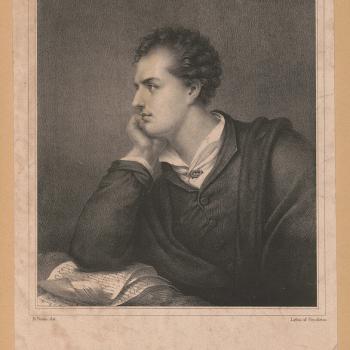Looking for the Byronic Hero Using Twilight's Edward Cullen

- Preview |
- Standards |
- Resources & Preparation |
- Instructional Plan |
- Related Resources |
- Comments
Overview
In this lesson, students access their own knowledge of characters from a variety of texts to make comparisons between the familiar concepts of hero and villain and the new concept of the Byronic hero, a term coined from Lord Byron and his writings in the 19th century. They first list heroes and villains with which they are familiar and discuss any examples that may blur the lines between the two. Using Stephenie Meyer's Twilight and the character Edward Cullen, students identify the characteristics of the Byronic hero in a Venn diagram and diagram other characters with these traits. Students then choose a project—an expository essay, photo collage, or book cover—to extend their understanding of this complex and compelling character type.
This lesson uses Edward Cullen as an example, but it may be adapted to focus on any Byronic hero that would be appropriate for your classroom.
Featured Resources
Examples of the Byronic Hero: This printable sheet includes lists of Byronic heroes in literature, comics, film, and video games.
From Theory to Practice
In her English Journal article "In Search of a Hero, in Search of a Self," Susan Arpajian Jolley notes that when discussing the definition of hero with her students, she "quickly discovered that students hadn't given much thought to the concept of heroism, except to regard firefighters and other emergency workers, especially those who were involved in the 9/11 rescue mission, as heroes" (24).
Just as students need to be challenged to refine and extend their thinking of heroes in real life, they can be moved to think critically about "Beowulf...and Macbeth, classic literary heroes who are prototypes of real and fictional characters in our modern world" (23). This lesson introduces students to a notion of hero that will challenge their thinking of the literary concept and encourage them to see complex shades of meaning between the terms "hero" and "villain."
Further Reading
Common Core Standards
This resource has been aligned to the Common Core State Standards for states in which they have been adopted. If a state does not appear in the drop-down, CCSS alignments are forthcoming.
State Standards
This lesson has been aligned to standards in the following states. If a state does not appear in the drop-down, standard alignments are not currently available for that state.
NCTE/IRA National Standards for the English Language Arts
- 9. Students develop an understanding of and respect for diversity in language use, patterns, and dialects across cultures, ethnic groups, geographic regions, and social roles.
- 10. Students whose first language is not English make use of their first language to develop competency in the English language arts and to develop understanding of content across the curriculum.
- 11. Students participate as knowledgeable, reflective, creative, and critical members of a variety of literacy communities.
- 12. Students use spoken, written, and visual language to accomplish their own purposes (e.g., for learning, enjoyment, persuasion, and the exchange of information).
Materials and Technology
- Markers
- Chart paper
- Internet connected computers
- Classroom computer with projector
Printouts
Websites
Preparation
- Title two sheets of chart paper (or sections of an overhead transparency): Hero and Villain.
- Arrange for use of an Internet-connected classroom computer with a projector.
- Make copies or a transparency of the handouts Examples of Byronic Heroes, Characteristics of the Byronic Hero, and Byronic Hero Projects. Fill in the blanks referring to due dates and requirements on the project descriptions prior to making copies.
- Arrange for computer access for Sessions Two, Three, and Four.
- Test the Venn diagram and other interactive tools for this lesson on your computer. Familiarize yourself with the tools and ensure that you have the proper Flash plug-ins installed. You can download the plug-in from the technical support page.
- Preview the Websites section for resources about the Byronic hero and bookmark them on your computer or student computers.
- Familiarize yourself with Twilight by Stephenie Meyer and other texts that feature a Byronic hero.
- For background information on Lord Byron, see The Life and Work of Lord Byron 1788-1824.
Student Objectives
Students will
- develop an understanding of the term Byronic hero, making comparisons between the traditional hero and the villain to see the characteristics that make up the Byronic hero.
- discuss several texts that feature a character who can be considered a Byronic hero.
- expand their understanding of the characteristics of the Byronic hero through a choice-based project.
Session One
- Begin the lesson by asking students to start listing characters from literature, movies, television shows, video games, and comics on the hero and villain charts you have posted in the classroom or on the overhead.
- After students have listed a number of characters, shift the discussion by asking them to list the reasons that certain characters were listed the way they were (e.g., Batman is the hero because he tries to save people, and the Joker is the villain because he tries to kill people).
- Look for (or introduce) examples that can complicate the distinction between hero and villain, such as Batman, the " Dark Knight."
- Introduce the concept of Byronic hero by sharing and discussing appropriate background information from the links provided and the Characteristics of the Byronic Hero.
- Have students review the characters they placed on the Hero and Villain charts and consider which of them might be appropriately placed in a "Byronic Hero" column.
Session Two
- Allow students to add any other characters to the Hero, Villain, or Byronic Hero charts from the first session. Also allow students to move any characters to other charts, justifying why they were added or moved.
- Explain to students that they will be delving deeper into the concept of the Byronic hero by examining one character: Edward Cullen from Twilight.
- Using a computer with a projector, share the Venn diagram with your students and discuss how the tool works.
- Using the book and movie Twilight by Stephenie Meyer, discuss Edward Cullen, the main vampire character, as an example Byronic hero. Use the Venn diagram to show how the character of Edward can be seen as the Hero, Villain, or Byronic Hero (overlapping area on diagram).
- Elicit from students traits or specific examples of behaviors or attitudes that help classify the character as a Byronic hero.
- Then ask students who are most familiar with the book and/or movie to discuss the significance of thinking about the character in this complex way, as neither traditional hero nor villain, but rather something that is in between.
Session Three
- Begin this session by reviewing the discussion of the Byronic hero and Edward Cullen from Session Two.
- Explain that students will now have a chance to apply their learning to a character of their choice, using the Examples of Byronic Heroes handout, the Characteristics of the Byronic Hero, and the Venn diagram tool to explore the complexity of the character.
- Ask students to choose a character (labeling their diagram with the character they chose) and to compare and contrast the aspects of the character by labeling one circle as "Hero" and the other as "Villain," showing the Byronic characteristics in the overlapping center.
- Give students time to complete their Venn diagram, reminding them that their work cannot be saved and should be printed prior to the end of the session.
Session Four
- Have students pair up for discussion of their printed Venn diagram. Students can partner with someone who did the same character and compare their answers and reasoning, or they can partner with someone who chose a different character to compare and contrast them.
- Pose the following questions to the students to think about after their partner discussion for either a continued partner discussion or a classroom discussion:
- For your character, what single characteristic was most dominant or obvious? Give examples.
- What common elements did they find most characters possessed?
- Did characters from different genres have significantly different character traits?
- For your character, what single characteristic was most dominant or obvious? Give examples.
Session Five
- Introduce the final project by distributing and discussing the Byronic Hero Projects handout with the students. Clarify due dates and any other pertinent information.
- Students opting to create a book cover can use the Book Cover Creator and the Book Cover Planning Sheets to help set up their book covers or use it as a guide or template. Students opting to write the expository essay can use the Story Map or the Literary Elements Map to help set up their essay or use it as a guide or template.
- Give students time to begin work on their projects in class so they can clarify, ask questions, collaborate, and use computers for the remainder of the class period.
- Because these projects are so varied, consider giving students a chance to use the Sample Project Rubric as a starting point for creating agreed-upon rubrics with criteria specific to the demands of each of the choices.
Extensions
- ReadWriteThink lessons that can enhance students' study of the concept of the hero, in real life and in literature include: Heroes Are Made of This: Studying the Character of Heroes, Tracking the Ways Writers Develop Heroes and Villains, and Heroes Around Us.
- Because this lesson relies heavily on student prior knowledge, follow up the lesson with the study of a new text that involves a Byronic hero to deepen their understanding of the character type.
- It is believed that the myth of Byron’s own personality. as well as his poetry, served as inspiration for the character of Heathcliff in Emily Bronte’s Wuthering Heights. Investigate this using the Masterpiece resource, "Heathcliff as Hero".
- This lesson also lists Mr. Rochester from Jane Eyre, and Heathcliff from Wuthering Heights. Examine scenes with those characters from the MASTERPIECE adaptations on PBS.
Student Assessment / Reflections
- Use students’ completed Venn diagrams to check for understanding before moving on to the final project.
- Assess students using the Sample Project Rubric or the rubrics the class created on their own.

Add new comment